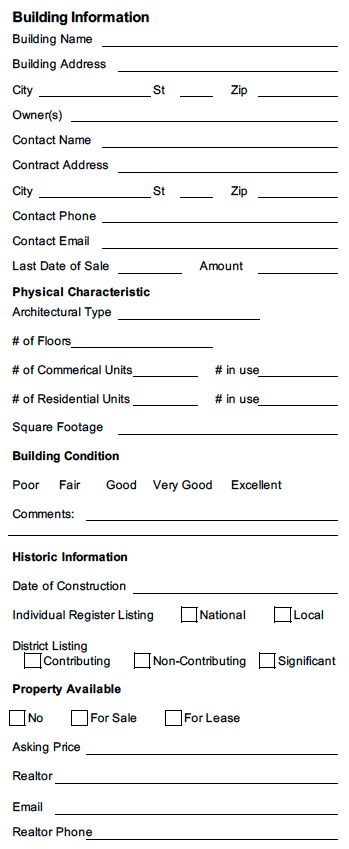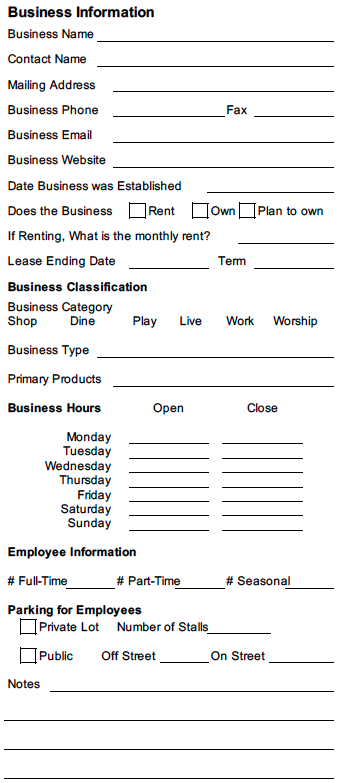In the past we have shared tools to help you get your downtown properties noticed and how to evaluate them using our property pro forma. This time we wanted to share a tool with you that can help you get your property and business database started (or updated).
Our District Inventory form is the perfect tool to get your census complete and get your database in great shape. Before we dive into the form itself, let’s take a moment to examine why this is such an important tool. For starters, if you don’t know what you have, it is really tough to manage it. There are a lot of properties in every downtown, and while you can get the list from the City, that doesn’t always tell you the entire picture.
The larger the district, the more difficult a census may be. I know from personal experience. As an Executive Director I was a staff of one and responsible for an area roughly 70 square blocks with close to 600 businesses. It wasn’t like walking door to door and getting all the information I wanted in an afternoon was an option. However, you have to start somewhere and you need to enlist the help of volunteers whenever possible.
That’s why we created this form, to make sure that whether it was myself or a volunteer who was helping us for a day, that we were getting the same information about our properties and businesses and could put together the most comprehensive database possible. That database ultimately led to a lot of what became Maestro Community Manager – but we’ll get to that later.
So let’s dive into the form itself. We created this form so that we could get both property and business information on the same form. There is a lot of information that we are collecting. It’s important to understand and accept going into this process that you will likely not get all the information on the form – or even everything you are hoping for. You will encounter people who don’t know the answers, owners who are reluctant to share the information thinking that you will share it or make it public. However, that should not deter you from getting the information that you can.
On the property side of the form, you will want to get the basic information such as address, but also the contact information. This is all something you should be able to get ahead of time from your city or county. Other information such as construction, for sale, national and local register information may also be accessible through other avenues such as a preservation commission, historical society or other type of organization. In fact, you wanted to you could pre-populate the forms with that information to ensure that you have covered everything during your canvasing. This is a wonderful tasks for those infamous interns.

When it comes to physical characteristics, you may not be able to get these without talking to the property owner or manager. For example, you may not know the building’s square footage, or number of residential units by simply looking at the exterior.
Building condition is a section that may require some coaching at the local level. This information can be very important in your preservation efforts as well as identifying areas that need to be addressed from a public safety standpoint. Having said that, you want to take as much subjectivity out as possible. What I view as a building in Good condition someone else may see as fair or poor. Having some training and setting expectations before you begin walking your district will create a more uniform evaluation of the property condition.
As you move to the business side of the form, you will see a lot of fields that are fairly common amongst downtown professionals. Of course, we want the business name, mailing address (especially if this is different than the physical address), and contact information. We also start to get key pieces of data such as the day the business opened, hours of operation, business classification and more.

There are also some things that would be considered confidential such as number of employees and whether the business rents or owns. Some business aren’t as comfortable sharing this information, but as you build trust you will start to get that information. Again, getting what you can is the most important piece of your census. You don’t want to push businesses away by demanding the information. You also want to ensure that whomever is doing your canvassing understands that this information is to be kept confidential.
So, once you have filled out your forms what do you do next. This is where Maestro can help. We were actually built around the Main Street model and this information can be plugged directly into the system. What’s more, once your data is in the system, future surveys can be done electronically and updated instantaneously.
The more data you have, the more powerful it becomes. You can find trends, see opportunities, and use the information to grow your district. If you want a copy of this inventory form, fill out our survey to the right and it will be emailed to you.
